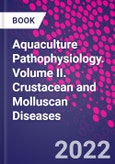Aquaculture Pathophysiology, Volume II. Crustacean and Molluscan Diseases is a concise, practical reference on shellfish diseases of significant risk to aquaculture. Its value to the veterinarian, fish health biologist or extensionist, fish pathologist and fish health diagnostician is its easy reach for critical information on the diagnosis and management of significant infectious and non-infectious diseases for the major temperate, subtropical and tropical shellfish species of commercial and fisheries importance. This volume should be read in partnership with volume one on finfish diseases as the principles and approach to the diagnosis and management of aquacultured animal species are similar.
This comprehensive resource is ideal for researchers, teachers, students, diagnostic laboratory scientists, aquaculture technicians, and farmers who need to be competent across both finfish and shellfish health issues.
Please Note: This is an On Demand product, delivery may take up to 11 working days after payment has been received.
Table of Contents
SECTION I. CRUSTACEAN DISEASES
1. Crustacean laboratory methods; 2. Crustacean Disease Terminology; 3. Crustacean immunology
SECTION II. VIRAL DISEASES
4. Covert Mortality Disease; 5. Crab viral diseases; 6. Crayfish viral diseases; 7. Infectious hypodermal and hematopoeitic necrosis virus disease; 8. Infectious myonecrosis virus disease; 9. Lobster Panulirus argus virus (PaV1) disease; 10. Monodon slow growth syndrome; 11. Spherical baculovirosis; 12. Shrimp Hemocyte Iridescent Virus (Decapod Iridescent Virus 1); 13. Taura syndrome virus disease; 14. Tetrahedral baculovirosis; 15. White spot syndrome virus disease of shrimp; 16. WSSV in wild mudcrabs; 17. White tail disease; 18. Yellow head virus disease
SECTION III. BACTERIAL DISEASES
19. Acute hepatopancreatic necrosis disease; 20. Crab larval luminescent vibriosis; 21. Chitinolytic Shell Disease; 22. Lobster Gaffkemia; 23. Mitten crab tremor disease; 24. Necrotising hepatopancreatitis (Hepatobacter penaei); 25. Shrimp mycobacteriosis; 26. Shrimp rickettsial disease; 27. Shrimp vibriosis
SECTION IV. PARASITIC DISEASES
28. Bitter crab disease (Hematodinium); 29. Crab ciliate disease (Mesanophrys); 30. Grey crab disease (Paramoeba perniciosa); 31. Lobster bumper car disease (Anophryoides haemophila); 32. Mud crab Octolasmis spp. barnacles; 33. Shrimp fouling organisms; 34. Shrimp gregarines (White Feces Syndrome); 35. Shrimp haplosporidiosis
SECTION V. FUNGAL DISEASES
36. Cotton shrimp; 37. Crab Lagenidium disease; 38. Crayfish plague; 39. Crayfish Thelohania disease; 40. Enterozytozoon hepatopenaei microsporidiosis; 41. Lobster Haliphthoros disease; 42. Shrimp Fusarium disease; 43. Shrimp larval mycosis
SECTION VI. NUTRITIONAL DISEASES
44. Vitamin deficiencies in shrimp; 45. Soft shell and blue shell syndrome in shrimp; 46. Crab larval mortality and nutrition
SECTION VII. ENVIRONMENTAL DISEASES
47. Black gill disease in shrimp; 48. Endocrine disruption in crustacea; 49. Pollutant toxicoses
pesticides, heavy metals, industrial organic chemicals in crustaceans; 50. Shell diseases; 51. Lobster Epizootic Shell Disease
SECTION VIII. GENETIC AND NEOPLASTIC DISEASES
52. Abdominal segment deformity in shrimp; 53. Inbreeding of shrimp, crabs and lobsters; 54. Neoplasia in decapod crustacea
SECTION IX. MOLLUSK DISEASES
55. Molluscan Disease Laboratory Methods; 56. Molluscan Disease Terminology; 57. Mollusk immunology; 58. Pearl Oyster Diseases; 59. General Pathology and Diseases of Abalone
SECTION X. VIRAL DISEASES
60. Abalone herpesvirus; 61. Diseases of viral origin in clams, mussels and scallops; 62. Hemocytic infection virus disease (oysters); 63. Ostreid Herpesvirus Disease; 64. Oyster velar virus disease; 65. Viral gametocytic hypertrophy (oysters)
SECTION XI. BACTERIAL DISEASES
66. Vibriosis of Larval Scallops; 67. Nocardiosis in Oysters; 68. Scallop Chlamydia and Rickettsia-like organisms; 69. Vibriosis in green mussels
SECTION XII. PARASITIC DISEASES
70. Bonamiasis; 71. Molluscan haplosporidiosis; 72. Kidney coccidiosis (scallop, abalone, mussels, oysters, clams); 73. Marteiliosis; 74. Mikrocytosis mackini; 75. Nematopsis protozoan infections; 76. Perkinsosis; 77. Shell boring polychaetes (Mudworms) and sponges affecting oysters, scallops and abalone.��
SECTION XIII. FUNGAL AND NUTRITIONAL DISEASES
78. Ostracoblade implexa disease (oysters); 79. Sirolpidium zoophthorum larval mycosis; 80. Microsporidiosis (Steinhausia mytilovum); 81. Hatchery Nutritional Conditions of Mollusks
SECTION XIV. ENVIRONMENTAL DISEASES
82. Pollutant toxicoses of mollusks; 83. Endocrine disruption in mollusks; 84. Ocean acidification�
SECTION XV. GENETIC AND NEOPLASTIC DISEASES
85. Inbreeding, genetic selection and manipulation of oysters; 86. Hemocytic neoplasia in mollusks






![Aquaculture Market Size and Forecast, Global and Regional Share, Trend, and Growth Opportunity Analysis Report Coverage: By Product Type [Fish, Aquatic Plants, Crustaceans, Mollusca, and Others] and Culture Environment - Product Image](http://www.researchandmarkets.com/product_images/11667/11667003_60px_jpg/aquaculture_market.jpg)

